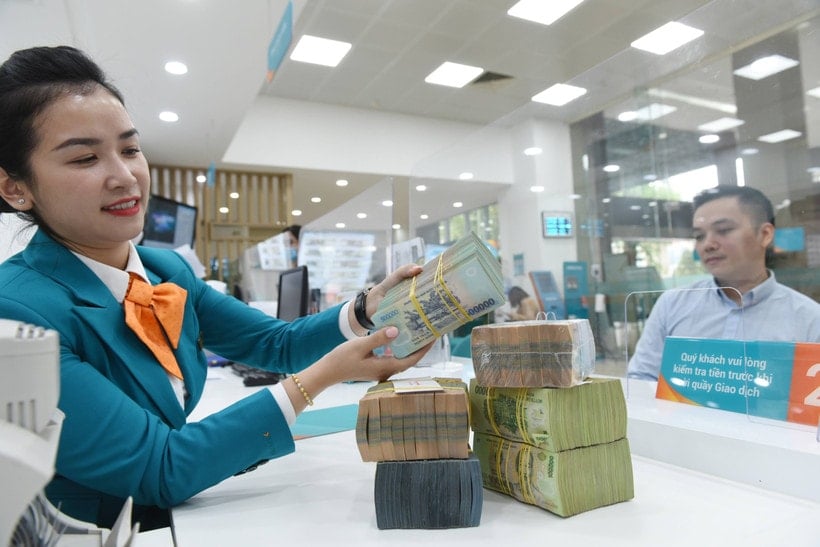
In the second half of 2025, banks such as SHB , OCB, MSB, VietABank... simultaneously announced plans to issue shares to pay dividends to increase charter capital and enhance risk buffers. This is a proactive response to increasing bad debt pressure and the State Bank's requirement to meet Basel II/III standards in a tightening direction.
Many banks simultaneously issue shares
Saigon - Hanoi Bank (SHB) announced that it will issue nearly 528.5 million shares, equivalent to 13% of its after-tax profit in 2024. After the issuance, the charter capital will increase from VND40,657 billion to VND45,942 billion. Notably, these new shares are not subject to transfer restrictions, contributing to increased liquidity. Previously, SHB also spent VND2,033 billion to pay a 5% cash dividend to shareholders.
Similarly, Maritime Bank (MSB) has also approved the implementation of increasing charter capital in 2025 through issuing shares to pay dividends to shareholders. This bank will issue a maximum of 520 million shares, equivalent to an issuance rate of 20% of the total outstanding shares. These additional issued shares will not be subject to transfer restrictions.
It is expected that after the successful issuance, the bank's charter capital will increase by VND5,200 billion, from VND26,000 billion to VND31,200 billion. The expected issuance time is in 2025.
LPBank also plans to issue more than 328 million shares to pay dividends at a rate of 19%, helping to increase charter capital by VND3,285 billion.
VietABank is also not out of the game, planning to issue more than 276 million shares to existing shareholders at a ratio of 100:51.19, thereby increasing capital from VND5,400 billion to VND8,164 billion. The source of capital for implementation comes from accumulated profits and the reserve fund to supplement charter capital.
At OCB, the bank will issue nearly 197.3 million shares, at a rate of 8%, from equity capital. Previously, in July 2025, OCB distributed a 7% cash dividend - the first time since listing.
In addition to the above names, many other banks such as VIB, Nam A Bank, VietBank, MB, Techcombank, BIDV, VietinBank, TPBank... are also implementing plans to increase capital by shares or cash this year.
Increase resilience
Paying dividends in shares instead of cash is becoming a popular choice, because it not only helps banks retain money to invest in technology and expand credit, but also improves the capital adequacy ratio (CAR), meeting the demand for credit growth in the context of economic recovery.
This is also how banks balance shareholder interests and long-term development strategies, especially when the State Bank encourages capital increases to strengthen the financial foundation of the system.

SHB leaders shared that issuing stock dividends is the optimal way to increase charter capital without external mobilization while ensuring the interests of existing shareholders and improving financial capacity to expand credit. Unrestricted transfer of shares helps stabilize market liquidity.
Similarly, OCB representative also said that the increased charter capital will be prioritized for expanding medium and long-term credit and investing in technology systems.
Experts say that when charter capital is larger, banks can increase lending limits, expand credit and invest in large projects. In the context of fierce competition between domestic banks and the participation of foreign financial institutions, large charter capital helps banks enhance their reputation, consolidate their position in the market, and have more resources to invest in new technology, products and services to attract customers.
In addition, raising capital through issuing shares to pay dividends instead of paying cash helps the bank retain cash flow for reinvestment, while still providing value to shareholders by increasing the number of shares they own. This is especially important when the bank needs to maintain liquidity during the growth phase.
Associate Professor, Dr. Nguyen Huu Huan, Ho Chi Minh City University of Economics, commented that the above results demonstrate the determination of banks in applying international standards, contributing to increasing efficiency and ensuring capital safety. Compared to Basel II, Basel III has many new and more stringent requirements. The implementation of Basel III also requires large financial resources as well as careful preparation from banks.
Sharing the same view, Dr. Can Van Luc - a banking and finance expert, said that despite massive capital increases, the CAR ratio of Vietnamese banks is still much lower than that of the region. For commercial banks, increasing charter capital is not only to meet capital safety standards according to Basel III, but also to improve competitiveness, increase the ability to respond to risks, and strengthen financial capacity...
“Currently, only a few banks meet the capital safety standards according to Basel III, therefore, most banks are facing pressure to increase capital in the following years,” said Mr. Can Van Luc./.

The State Bank has just issued Circular No. 14/2025/TT-NHNN regulating capital adequacy ratios for commercial banks. Circular 14 provides guidance on how to determine and the minimum values of capital adequacy ratios that banks must maintain, including core capital ratio tier 1, tier 1 capital ratio and minimum capital adequacy ratio.
Accordingly, commercial banks without subsidiaries or foreign bank branches must maintain individual capital adequacy ratios including: minimum core capital ratio of 4.5%; minimum tier 1 capital ratio of 6% and minimum capital adequacy ratio of 8%. For commercial banks with subsidiaries, individual and consolidated capital adequacy ratios must also meet the corresponding levels: minimum core capital of 4.5%, minimum tier 1 capital of 6% and minimum capital adequacy ratio of 8%.
Source: https://baohaiphongplus.vn/ngan-hang-dua-tang-von-dieu-le-cung-co-bo-dem-du-phong-rui-ro-417535.html
























































![[Maritime News] Container shipping faces overcapacity that will last until 2028](https://vphoto.vietnam.vn/thumb/402x226/vietnam/resource/IMAGE/2025/7/30/6d35cbc6b0f643fd97f8aa2e9bc87aea)













































Comment (0)